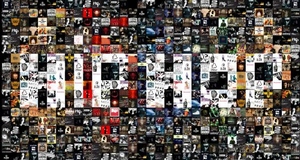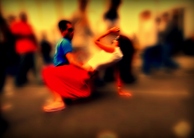Hip-Hop is for Everybody: Examining the Roots and Growth of Hip-Hop
By
2012, Vol. 4 No. 05 | pg. 1/2 | » Starting from humble roots, hip-hop has grown from the creative outlet of underrepresented black teenagers living in the South Bronx in the late 1970s to a highly successful commercialized business that in 2000 grossed over $1.8 billion in sales in the United States. (Kun, 581) Hip-hop is not only successful in the United States, but also, its influence has permeated the entire planet, becoming a global creative and economic force. Historically the genre has been considered representative of the voice of the black community, but some critics argue that the commercialization and globalization of hip-hop music dilutes its message so that the genre no longer truly represents the voice of the black community. In his 1999 manifesto “Fear Not of Man,” the highly acclaimed rapper Mos Def proclaims, “We are hip-hop.” (Mos Def, 1999) Who is the “we” Mos Def is referring to? Who exactly constitutes hip-hop? Traditionally this “we” would be interpreted as America’s black community, but, as we have seen, the consumers and producers of hip-hop have expanded far beyond the black community. Mos Def recognizes the ever expanding base of hip-hop and later in “Fear Not of Man” states that, “Me, you, everybody – we are hip-hop,” suggesting that hip-hop music no longer solely represents solely the voice of the black community, instead, hip-hop now represents all those who partake in or promote hip-hop culture whether male or female, rich or poor, black or white, American or foreign, and so on. (Mos Def, 1999) In today’s commercial world, hip-hop has even gone so far as to represent various companies and products. After an analysis of the roots of hip-hop and the growing commercialization and globalization of the genre, it becomes evident that Mos Def’s assessment is correct and hip-hop currently represents far more than the black community.The roots of hip-hop date back to the South Bronx in the 1970s, when the construction of the Cross-Bronx expressway displaced many black and Hispanic families while many whites fled the area. Renewal projects also caused massive relocations of economically delicate blacks and Hispanics into the South Bronx. (Rose, 30) These displaced citizens were left with “few city resources, fragmented leadership, and limited political power” and the South Bronx started to become depicted as “drained of life, energy, and vitality.” (Rose, 33) The youngest generation of these relocated families began frantically searching for outlets to channel their creativity and aggression, and soon hip-hop emerged, providing black youths with an identity and cultural support groups through deejaying, rapping, break dancing, and graffiti production. (Rose, 33-34) Author Tricia Rose suggests in her seminal masterpiece, Black Noise, that rap is deeply rooted in “premodern oral traditions” while hip-hop itself follows in the footsteps of previous black musical styles such as jazz, blues, and southern soul music. (Rose, 21, 185) These genres of music all have historic roots in black culture and society and were later commercialized and expanded to wider audiences, both globally and ethnically: something that is currently happening to hip-hop. Early rappers voiced their frustrations of a society in which urban blacks were oppressed, powerless, vulnerable, and underrepresented. The first rappers criticized institutions such as the police, the government, and media, as well as the discrimination faced by blacks; the themes in these songs clearly representative of the plight of blacks. (Rose, 106) Boogie Down Productions’ 1989 song “Who Protects Us From You?” is a prime example of themes used in early rap songs, commenting on the ills of police brutality and racism. (Rose, 106) These early rap artists such as Grandmaster Flash and the Sugarhill Gang were signed to small independent labels and those not a fan of the genre assumed rap and hip-hop would be a passing fad. (Rose, 6) However, doubts of hip-hop’s ability to become a viable commercial force were quelled in 1979 when the Sugarhill Gang’s song “Rapper’s Delight” sold millions of copies and rose to the top of the charts, establishing hip-hop as a true commercial force. (Rose, 6) The economic triumph of “Rapper’s Delight” also gave evidence to the fact that demographics of hip-hop consumers were growing to encompass more than just urban blacks. Hoping to profit from the commercial success of hip-hop, the six major record labels (CBS, Polygram, Warner, BMG, Capitol-EMI, and MCA) started purchasing the independent labels, with the hope of reaping the benefits derived from the toil of these smaller labels that originally brought hip-hop to prominence. (Rose, 7) After the major labels bought out the smaller independent companies, there was a noticeable shift in the lyrical content of hip-hop. (Hurt, 2006) Whereas, previously the lyrics focused on social, political, and cultural issues, the lyrics now were becoming more hyper-violent and hyper-masculine, eventually coming together as a new genre known as “Gangsta Rap” which rose in popularity and sales while being heavily promoted by the major labels. (Hurt, 2006) Along with the major label’s growing interest in hip-hop, MTV’s decision to air “Yo MTV Raps” in 1989 helped mark the emergent influence and commercialization of rap. This moment is significant in hip-hop history, as prior to this show, MTV had never devoted much airtime to hip-hop or black artists in general, fearing its predominately white teen audience base would not be receptive of the content. (Rose, 8) “Yo! MTV Raps” became highly successful and confirmed that hip-hop could be especially “marketable to white suburban teens” as well as the original black audience base. (Rose, 8) The premiering of “Yo! MTV Raps” influenced a monumental shift in hip-hop culture as now music videos became a major factor in hip-hop. By airing music videos on MTV, hip-hop artists were able to gain visibility and expand the genre’s audience base to an ever-growing white market. With the growing importance of music videos, there was an “increased focus on how a singer looks rather than how he or she sounds” and soon rappers and their music labels were crafting images to go along with the musical content. (Rose, 9) Prior to the success of hip-hop on MTV, the genre’s music videos frequently “functioned as a snapshot in the lives of the artist,” and generally depicted the rapper hanging out in his neighborhood (generally “black urban inner-city locations”) with his or her “posse.” (Fitts, 221, Rose, 10) However, after the commercialization of hip-hop, the major labels had more control of the creative process and soon music videos became a “quasi-cinematic, sensationalized illustration of the persona of the artist” in order to appear more marketable to Top-40 demographics. (Rose, 13, Fitts, 221) The generic, industrial standard of hip-hop videos of this modern era often display rappers “ego-stroking” by making glorious displays of wealth and power. (Fitts, 212) While watching a standard contemporary music video, one will often see scantily clad women parading around the rapper’s mansion, entertaining the rapper and his “posse.” One anonymous music video director has even stated that it has gotten to the point where “it’s all about the hot girls” and the social and political messages behind the lyrics have taken a back seat. (Fitts, 218) Violence and hyper-masculinity were once again major themes present in the videos produced by the major labels. When given the choice to air a cutting edge music video or a generic one that makes use of these violent and sexist elements, record labels will generally use the latter for fear that the audiences would be unreceptive of deviations of formulaic rap music video. (Fitts, 224) Hip-hop appears to have gone away from the socially, culturally, and politically critical messages dealing with the plight of generally voiceless blacks to an expression of wealth, power, and hyper-masculinity. In an interview featured in Byron Hurt’s documentary Hip-Hop: Beyond Beats and Rhymes, Mos Def commented on the presentation of rappers, stating that in the current rap and hip-hop culture, rappers have to assert themselves physically to seem powerful and worthy of respect; even he, as a self confessed bookworm, believes that rappers need people to know that they are not weak or docile. (Hurt, 2006) It might seem odd that rappers would portray such stereotypical and possibly self-degrading image of themselves by continuing to write songs and make videos laced with violent, sexist, egotistical, and hyper-masculine lyrics, visuals, and overtones. However, as it turns out, rappers seems to have less of a choice than one would think. In Hurt’s documentary, young rappers were seen rapping about very violent and sexist topics with the aspirations of one day signing with a major label and becoming famous. When these young artists were asked why they rap about such deplorable topics with arguably little social meaning, they responded that they would prefer to rap about more “righteous” things as the first rappers had done. (Hurt, 2006) These aspiring rappers insist that the reason for continuing producing “Gangsta Rap” over music with more social and culturally meaningful lyrics is that they firmly believe that the record industry only wants to see the image of tough black males. Marko Fitts, the author of “Drop It Like It’s Hot” laments that hip-hop has so abandoned the original social and political themes that the “historical mantra of ‘keepin’ it real” is only a “fragile prospect.” (Fitts, 224)Continued on Next Page » Suggested Reading from Inquiries Journal
Inquiries Journal provides undergraduate and graduate students around the world a platform for the wide dissemination of academic work over a range of core disciplines. Representing the work of students from hundreds of institutions around the globe, Inquiries Journal's large database of academic articles is completely free. Learn more | Blog | Submit Latest in Music |


















